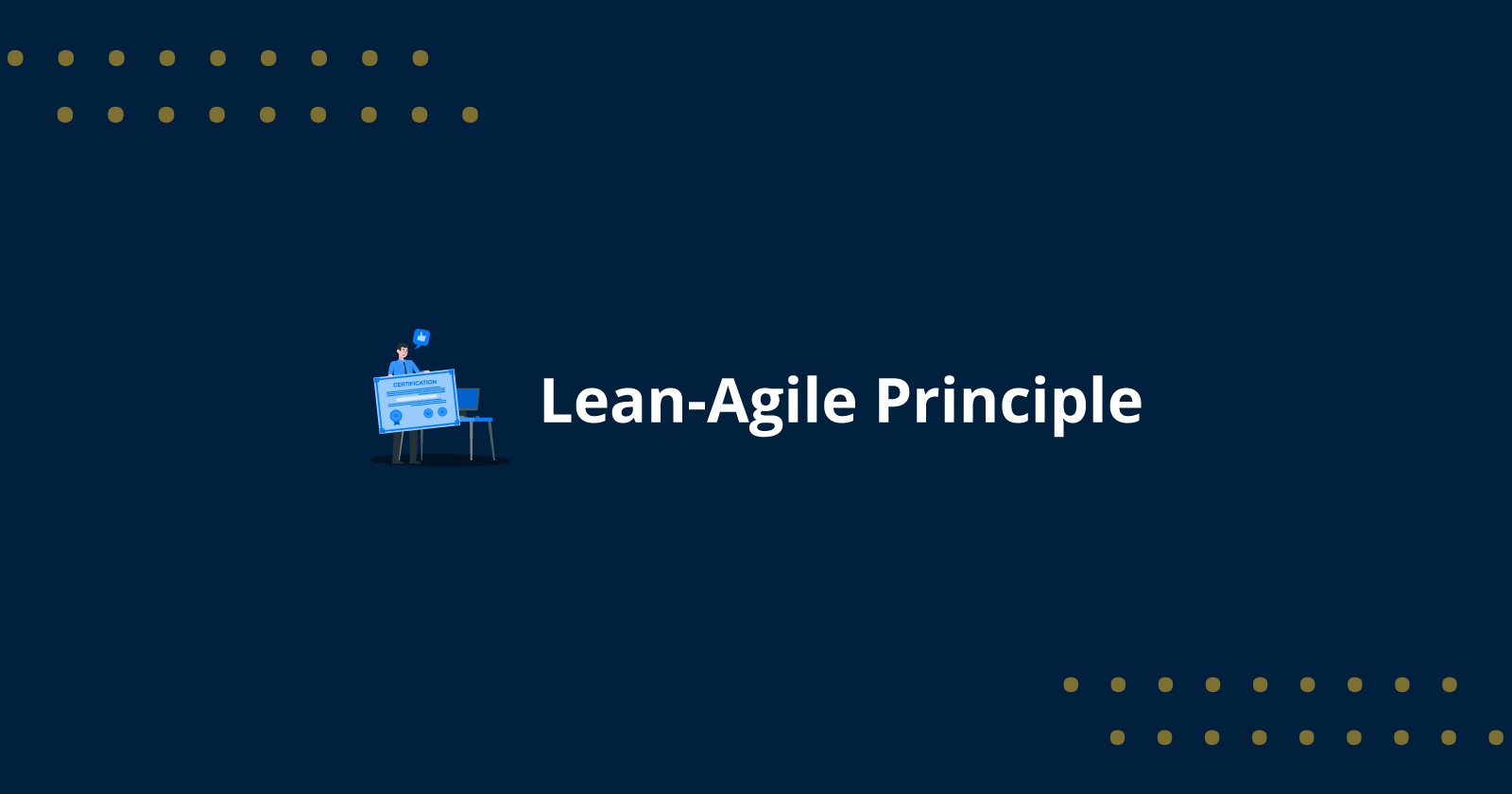Introduction:
Imagine what if your team were able to achieve more while performing more with less effort? This is not done by making sacrifices or degrading quality, but also by avoiding distractions, unwanted tasks, and wasted resources. This is at the heart of Lean-Agile, an established method that focuses on providing maximal value while minimizing loss.
Think about working for a company that is hassle-free and uses only your tools. You'll be more focused as you can accomplish more with less effort. Also, you can apply the concept across your entire business. Lean-Agile helps smooth processes, sharpen priorities, and help teams concentrate on the most important things, making a difference for their clients.
Organizations looking to expand Lean-Agile concepts across the entire company expect frameworks such as Scaled Agile Framework (SAFe) to achieve long lasting changes. This blog will teach how Lean began, the reasons why Lean-Agile is crucial to modern-day project management, and the five principles of Lean-Agile that are the driving force behind efficiency, collaboration, and continuous growth.
What is the Lean Agile Principle?
The Lean- Agile concept is a combination of two different methodologies: Lean & Agile. In this variation, Lean concentrates on reducing inefficiencies & optimizing processes for maximum efficiency, while Agile focuses on flexibility, collaboration, and the development of iterative processes to meet the needs of customers efficiently.
The fundamental idea behind the Lean Agile process is to build a culture that is constantly improving and flexible. This method allows organizations to quickly respond to evolving markets, cut down on the time to market, and increase overall team effectiveness. The Lean-Agile concepts and practices promote a change from hierarchical systems towards a more cooperative and a more customer-centric approach.
Some of the key aspects of the Lean-Agile methodologies are:
- Delivering value in smaller, incremental steps
- Creating collaboration across teams
- Believing in change and constant advancement
- Optimizing workflows
When they adopt Lean and Agile concepts, companies are able to achieve a balance between quality, speed, and customer satisfaction.
Also, check:Lean Agile Leadership
Benefits of Agile and Lean Principles
The implementation of Agile along with Lean principles offers various benefits for businesses. Here are a few significant advantages:
- Improved Time to Market: Lean-Agile development can help organizations launch more quickly by breaking down big tasks into manageable tasks & smaller projects. This approach is continuous production and better feedback loops.
- Better Quality: Through regular evaluation & feedback from teams, they will be able to spot and resolve issues early throughout the development process and produce better products.
- More satisfied customers: By making sure that they provide the best value to their customers while also adapting to changing requirements, businesses can boost customer satisfaction and increase loyalty.
- A Better Collaboration: The Lean-Agile principles encourage cross-functional collaboration and make it easier for teams to collaborate effectively and exchange information.
- Reduction of Waste: Lean methods focus on identifying and eliminating value-adding processes, which reduces consumption and improves the use of resource utilization.
- More Effective Risk Management: By utilizing short feedback loops and more frequent delivery, teams are able to identify the risk in advance and implement corrective actions to minimize the risk.
Principles of Lean Agile
The 10 principles of Lean Agile form the foundation for implementing this methodology effectively. These principles guide organizations in creating a culture of continuous improvement and adaptability:
1. Economic View
Understanding the economy of a system is essential to minimize development costs and reduce time-to-market. Every contributor should be aware of the financial impact of their decisions in product development. Prioritizing economic value ensures organizations achieve the best possible outcomes with limited resources.
The Economic View can be achieved through:
- Delivering early and delivering often
- Operating within a lean budget
- Understanding solution economic trade-offs
- Leveraging suppliers effectively
- prioritizing jobs to earn maximum benefits
Key Benefit:
Taking an economic view helps teams balance cost, value, and risk, ensuring they focus on delivering high-value features faster and more efficiently.
2. Apply Systems Thinking
Systems Thinking is about viewing the organization and its processes comprehensively, considering every aspect of the system and its environment during design, development, deployment, and maintenance. It focuses on optimizing the entire system rather than individual components.
Key Aspects of Systems Thinking:
- The solution and the system are one and the same – Focus on the overall solution rather than just its parts.
- The enterprise itself is a system – The organization should operate like a cohesive system to ensure value delivery.
- The entire value stream must be optimized – From concept to delivery, optimize every stage to reduce delays and waste.
Key Benefit:
Systems Thinking helps both leaders and teams understand the ‘what’ and ‘why’ behind their work, leading to better quality outputs and more sustainable systems.
3. Assume Variability; Preserve Options
In Lean-Agile, variability is necessary, and preserving multiple options during development helps manage uncertainty. Instead of locking into one solution early, use a set-based design approach by exploring multiple solutions at the start and narrowing down options based on feedback and learning.
Steps to Manage Variability:
- Accept current variability and redefine it through future iterations
- Keep options open until more is known
- Preserve design flexibility for future changes and adaptations
Key Benefit:
This principle leads to better decision-making by continuously refining options and choosing the best path based on evolving knowledge and needs.
4. Build Incrementally with Fast, Integrated Learning Cycles
Delivering value in small, incremental builds reduces risk and enables faster feedback. Building increments frequently allows customers to view and test the system, providing valuable understanding for improvement.
Benefits of Incremental Building:
- Reduces risk by testing smaller increments regularly
- Acts as a prototype for market validation
- Creates data points to guide future decisions
- Improves technical feasibility by validating designs through integration
Key Benefit:
Incremental builds allow rapid learning cycles and ensure that even in complex systems, integration points validate the system’s ability to meet customer needs.
5. Base Milestones on Objective Evaluation of Working Systems
Traditional project milestones often focus on completing tasks or phases, but Lean-Agile principles emphasize evaluating progress based on working solutions. Each milestone should deliver tangible, tested outputs that provide value.
How to Evaluate Milestones:
- Use objective evidence to track progress
- Ensure every milestone covers the entire SDLC (Software Development Life Cycle), from requirements to testing
- Focus on value increments rather than arbitrary deadlines
Key Benefit:
Objective milestones ensure real progress is made, with each milestone contributing functional value to the end product.
6. Make Value Flow Without Interruptions
Achieving continuous flow is essential for delivering value efficiently. The principle focuses on reducing Work In Progress (WIP), managing batch sizes, and minimizing queue lengths to ensure smooth delivery.
Steps to Ensure Continuous Flow:
- Visualize the WIP to increase transparency
- Balance WIP with the team’s capacity to avoid overloading
- Limit WIP by reducing batch sizes for faster processing
Key Benefit:
A continuous flow allows teams to deliver new system features faster, ensuring that the organization can adapt to changing market needs.
7. Apply Cadence, Synchronize with Cross-Domain Planning:
Cadence refers to establishing a predictable rhythm for work, reducing uncertainty. Synchronization ensures that teams across different domains coordinate effectively and align their work.
Cadence Principles:
- Prevents variance accumulation by creating a regular rhythm
- Enables small batch sizes by providing regular intervals for delivery
- Creates predictability and reduces costs by turning unpredictable events into planned ones
Synchronization Principles:
- Synchronizes multiple projects to improve efficiency
- Reduces queues and helps manage dependencies
- Facilitates cross-functional trade-offs to ensure alignment
Key Benefit:
Applying cadence and synchronization helps teams plan better, coordinate efforts, and manage dependencies across large, complex systems.
8. Unlock the Intrinsic Motivation of Knowledge Workers
Traditional strategies that simply depend upon the concept of compensation to motivate employees are often ineffective with workers who have knowledge. Instead, Lean-Agile practices focus on the development of inner motivation by providing an individual's autonomy, a purpose & positive surroundings.
How to Motivate Knowledge Workers:
- Give employees autonomy and allow them to be in charge of their jobs
- Establish a clearly defined purpose and goal - Allow workers to comprehend the larger perspective
- Make a collaborative and empowering atmosphere - encourage open interaction and feedback
Key Benefit:
Workers who are motivated work better, are more innovative, and are more effective in achieving organizational objectives.
9. Decentralize Decision-Making
Centralized decision-making may be the reason for delays. The Lean-Agile principles suggest centralizing routine tasks to permit teams to react faster to any changes.
When to Decentralize:
- Recurrent problems
- Time-critical decisions
- Local context is required for decisions
When to Centralize:
- Strategic decision-making
- Product strategy
- Trade-offs in economic terms that are significant
Key Benefit:
Decision-making that is decentralized improves flow speed feedback loops and can lead to better solutions.
10. Organize Around Value
Traditional organizational structures tend to focus on specific departments or functions, which can result in barriers and decreased effectiveness. The Lean-Agile principle calls to organize around value streams, which ensures that all aspects of an organization are centered on providing value to the client.
Steps to Build a Value-Based Organization:
- Think about organizational structure
- Learn about the value flow
- Group teams into Agile Release Trains (ARTs)
- Align value streams into portfolios
Key Benefit:
An organization that is based on value delivers customer satisfaction faster, cuts down on waste, and makes sure that the teams work towards the same goals.
Why is it important?
The adoption of Lean-agile practices is essential for companies to stay at the forefront of today's competitive marketplace. This is why it's important:
- Respond to Market Changes Quickly: In the always dynamic marketplaces, companies must be adaptable and flexible. Lean-Agile methodologies allow them to adapt to the needs of customers and changes in the market more quickly.
- Improve Customer Experience: If they focus on providing value by delivering value, companies will improve customer satisfaction and develop long-lasting relations.
- Increase Efficiency and Productivity: Lean practices help eliminate waste & make the processes smooth, leading to higher efficiency and higher productivity.
- Foster Innovation: The Lean-Agile approach allows teams to explore new ideas and develop and continually optimize their practices.
- Enhance Employee Engagement: Through empowering teams and encouraging a culture of respect, organizations can boost employee engagement and satisfaction.
- Reduce Costs: The elimination of waste and the optimization of processes can reduce operating costs and increase profits.
Conclusions
The Lean-Agile concept is an effective strategy that brings together the finest practices of Lean and Agile techniques to offer the value of customers' time more quickly, enhance quality, and drive continual advancement. When adopting the Lean-Agile approach and principles, companies are able to improve efficiency, increase the satisfaction of customers, and stay relevant in the current business context.
It doesn't matter if its development uses Lean-Agile methodology, Lean-Agile, or Lean/Agile leadership concepts. Adopting this method is crucial to fostering innovations, enhancing workflows, and achieving sustained increases.
While businesses navigate the ever-changing market landscape, adopting Lean and Agile concepts will be crucial in staying ahead of the trend and providing outstanding value to clients. By focusing on continual improvements, collaboration, and flexibility, companies will be able to sustain their long-term growth in a constantly changing world. If you want to gain more in-depth knowledge about the Lean-Agile Principle, you can easily go through the Simpliaxis SAFe Agilist Certification Training. Our comprehensive Training sessions are designed based on the specific needs of the business & provide well-preparation in a Lean agile environment.













 +1-361-998-9988
+1-361-998-9988


